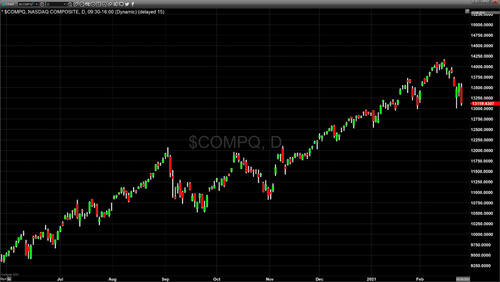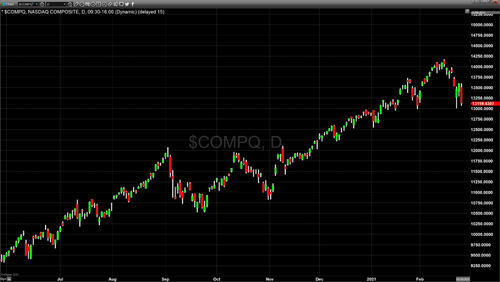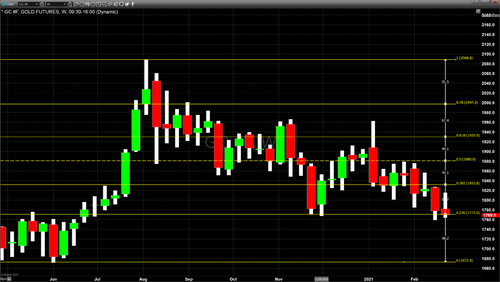

In what was a frenzy of selling pressure, market participants bid U.S. equities, and the entire precious metals complex substantially lower in trading today. The hardest-hit stock indexes today were undoubtedly the NASDAQ composite and the Russell 2000. The NASDAQ composite experienced its worst trading day in four months, giving up – 3.45%, or 460 points, to close at 13,138.5143.

The Dow Jones Industrial Average recovered slightly from the intraday low in which the Dow traded roughly 650 points lower. The net result of selling pressure in the Dow was a drawdown of - 1.75%, or 559.85 points taking that average to 31,402.01. The S&P 500 lost 2.45% or a decline of 95.18 points, with that index closing at 3829.25.
The precious metals complex lost significant ground, with gold futures losing $25.80, or - 1.44%, with the most active April 2021 Comex contract closing at $1772.90. Silver also had a significant decline of -1.85% or $0.51.4, with the March 2021 Comex contract closing at $27.345. Platinum futures also felt the selling pressure losing 2.68%, or $33.70 on the day, with the most active April 2021 Comex contract currently fixed at $1224.20.

The underlying event that led to the mass-selling frenzy that occurred today was rising yields in U.S. bonds. The 10-year Treasury note traded to its highest value in a year.

According to MarketWatch, "A rise in bond yields, with the 10-year Treasury note TMUBMUSD10Y, 1.519% advancing to above a psychological threshold at around 1.5%, has put pressure on stocks and gold, forcing investors to reassess the relative value of owning either asset against the backdrop of richer rates from risk-free Treasuries."

There is a contradiction between the recent rise in U.S. bonds and note yields and the Federal Reserve's current mandate to maintain interest rates between zero and 25 basis points throughout 2021 and into 2022.
The critical difference between investors' market sentiment and the Federal Reserve's current mandate is the timeline in which traders versus the Federal Reserve believe it will stabilize the economy. The Federal Reserve remains more cautious and has vowed to keep interest rates exceedingly low. However, market participants are more bullish in terms of the timeline and have been bidding yields on bonds and notes higher.
According to Reuters, members of the Federal Reserve "are shrugging off the surge in longer-term U.S. government bond yields as a sign of growing optimism about the economy, which could pick up steam as more people receive vaccinations against the coronavirus." The report also cited that "Fed officials said the increase in yields is a reflection of the confidence that a robust economic recovery is on the horizon for the second half of the year, as more vaccines are distributed and with more fiscal stimulus likely on the way."
The Kansas City Fed President Esther George told farm executives and a virtual event today that, "Much of this increase likely reflects growing optimism in the strength of the recovery and could be viewed as an encouraging sign of increasing growth expectations."
The majority of Federal Reserve members believe that the recent rise in bond yields does not warrant a central bank response.
The Federal Reserve will continue its current course and mandate of maximum employment by keeping interest rates low and the continued purchase of $120 billion a month in government bonds and mortgage-backed securities. This will continue until the economy is much stronger and headed towards recovery to pre-pandemic days.
By Gary Wagner
Contributing to kitco.com
Try Kinesis Money System Exchange Gold, Silver and CryptoCurrency
